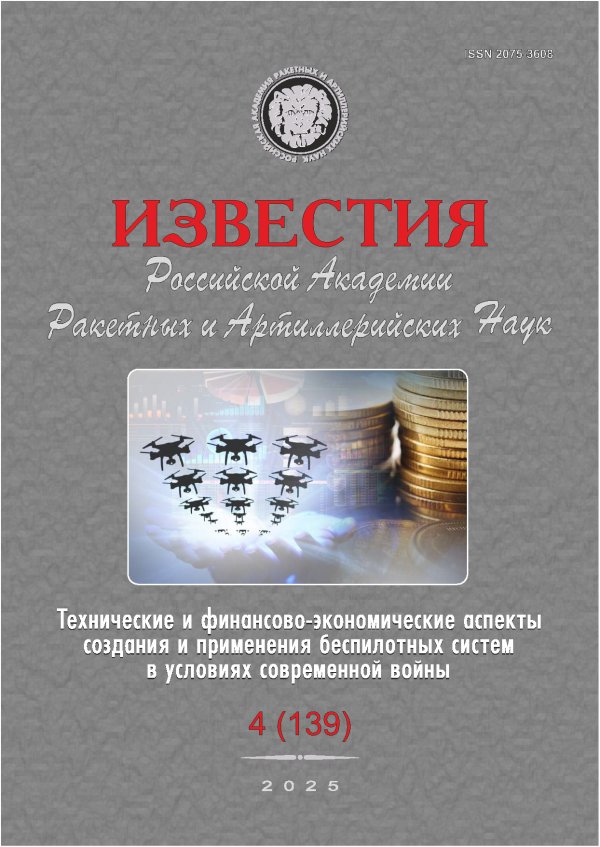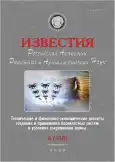Izvestiâ Rossijskoj akademii raketnyh i artillerijskih nauk
ISSN (print): 2075-3608
Media registration certificate: ПИ № ФС 77 - 37388 от 27.08.2009
Founders
- Scientific and Production Association of Special Materials
- Russian Academy of Rocket and Artillery Sciences
Editor-in-Chief
- Silnikov Mikhail Vladimirovich, Academician of the Russian Academy of Sciences, Doctor of Technical Sciences, Professor
Frequency / Access
4 issues per year / Open
Included in
Higher Attestation Commission List, RISC
Current Issue
Vol 4, No 139 (2025): Известия российской академии ракетных и артиллерийских наук
- Year: 2025
- Articles: 22
- URL: https://journal-vniispk.ru/2075-3608/issue/view/24755
Articles
Technical, financial and economic aspects of the creation and use of unmanned systems in modern warfare
Abstract
The problem of digitalization of the military economy of the Russian Federation is considered in the aspects of development of end-to-end digital technologies in the inter-corporate environment of the defense-industrial complex (DIC) in our country. It is shown, that the solution to the problem of digitalization of the military economy is inextricably linked with the implementation of digital transformation of economic agents of the MIC.
 3-11
3-11


Digitalization of the Russian military economy in the aspects of the development of end-to-end digital technologies
Abstract
The article considers the task of digitalization of the military economy of the Russian Federation is considered in the aspects of development of end-to-end digital technologies in the inter-corporate environment of the defense-industrial complex (DIC) of Russia in our country. It is shown, that the solution to the problem of digitalization of the military economy is inextricably linked with the implementation of digital transformation of economic agents of the DIC.
 12-15
12-15


Improving the information support of special-purpose organizational and technical systems is a necessary condition for their effective use
Abstract
The article substantiates the need to improve the information support of special-purpose organizational and technical systems (SPO TS) through the use of remote sensing spacecraft (remote sensing). For this purpose, a brief retrospective analysis carried out, a method is substantiated for increasing the information capabilities of the SPO TS at the expense of the domestic orbital grouping by promptly deploying a low-orbit multi-satellite grouping based on the small spacecraft as a functional complement.
 16-21
16-21


Distributed active phased array antenna with synthesized stochastic aperture based on a swarm of small spacecraft
Abstract
The article presents a distributed spaceborne AESA concept based on a swarm of small satellites. The key distinction is a stochastic synthetic aperture: each satellite digitizes I/Q signals with precise time and coordinate tagging. A central cluster performs synchronization, calibration, phase compensation and digital beamforming. This enables global, high-resilience, reconfigurable next-generation systems — far more flexible and fault-tolerant than monolithic spacecraft.
 22-31
22-31


Determining the throwing angle correction to hit the target at a given height
Abstract
A solution is given to the problem of determining the angle of projectile throwing to hit a target at a given height, the relevance of which is determined by the lack of an analytical expression for the trajectory of the ammunition. There is a mathematical model of projectile motion in the air in the form of a system of differential equations. The proposed method is based on the integration of a system of equations for the plane motion of a projectile in the air.
 32-36
32-36


Methodology for calculating the probability-time characteristics of the flow of command-program information in multilevel hierarchical control systems
Abstract
A methodology has been developed for estimating the probabilistic-temporal characteristics of the flow of command and program information in multilevel hierarchical control systems. When modeling the passage of signals, the limitations caused by the cyclical movement of consumers of target information are taken into account. The developed methodology includes the implementation of simulation cycles and requirements for the probability of preventing unauthorized access to the automated control system (ACS).
 37-43
37-43


The methodology of updating predictive information based on the bayesian approach
Abstract
A methodology for updating predictive information is presented, which is based on the application of the Bayes formula to clarify the a posteriori probability of predicted events as new data becomes available indicating their likelihood. The content of the stages of the methodology implementation with practical examples for quantitative and qualitative assessments is given. Variants of visualization of forecasting results and their interpretation are proposed.
 44-49
44-49


Scientific and methodological approach to evaluating the effectiveness of the facility security system
Abstract
The main factors affecting the effectiveness of the security system of the control facility, the specifics of the use of engineering and technical means, taking into account possible patterns of violations, are considered, a generalized criterion for the effectiveness of the security system is justified, allowing to manage the safety of the facilities of the control system, and the procedure for determining it.
 50-56
50-56


Scientific foundations of the design of ultraviolet water purification units in the interests of creating promising means of field water supply
Abstract
Using theoretical concepts of photochemical processes of detoxification of chemical warfare agents in water under the influence of ultraviolet radiation in the presence of strong oxidizing agents, basic principles and mathematical expressions are given that allow calculations and design of photochemical water purification units as part of field water supply facilities, and substantiate their optimal operating modes.
 57-65
57-65


Dynamic training simulator for combat training armored transporter calculation
Abstract
The article discusses the structure of a dynamic simulator for training combat crews of the BTR-80A armored personnel carrier. A structural diagram of the dynamic simulator and its components is presented. Training on this simulator takes place in a synthesized background-target environment, simulating the dynamic similarity of the armored personnel carrier’s movement over rough terrain.
 66-75
66-75


Development of explosion protection devices for localization of explosive charges up to 10 kg in tnt equivalent
Abstract
The development of modular blast protection devices for localizing the detonation of explosive charges up to 10 kg TNT equivalent was examined. It was found that a design consisting of eight lightweight side sections more effectively reduces the level of excess pressure in the blast front than a design consisting of four heavier side sections.
 76-84
76-84


Alignment of guidance angles in the marine feed system artillery guns
Abstract
The article formalizes the description of the feeding system of modern naval artillery installations with cartridge feeding and provides a generalized diagram of the system. It also addresses the issue of uninterrupted ammunition delivery to the delivery line during continuous gun aiming. The article compares the main naval artillery installations that use axis-based feeding.
 85-89
85-89


Substantiation of the appearance of a unified system for remote and mobile monitoring of storage facilities for toxic and explosive substances
Abstract
The results of the study of the possibility of creating and substantiating the appearance of a unified system for remote and mobile monitoring of explosive and toxic substances storage facilities through the use of promising acoustic and pulse-thermocatalytic methods and detectors based on them capable of detecting maximum permissible and explosive vapor concentrations are presented. It is shown that the developed detectors make it possible to solve the problems of monitoring the maximum permissible and pre-explosive concentrations of components of liquid rocket fuels and hydrocarbon fuels.
 90-96
90-96


Researching the possibility of using algorithms of clusterization for the typification of aerodynamic configurations of missile weapon
Abstract
The article considers the problem of forming initial data for the design of external ballistics of aircraft, namely, the formation of aerodynamic characteristics of the projected aircraft. An approach to the formation of aerodynamic characteristics is proposed, an example of using the proposed approach is given, and an assessment of the applicability of the proposed approach to the problem being solved is given.
 97-103
97-103


Estimation of efficiency of onboard x-band radar sensor with linear frequency modulation
Abstract
Method of mathematical modelling of input signal of onboard radar target sensor with linear frequency modulation from complex shape target on the basis of its multipoint model is considered. Possibility of estimation the operation coordinate of onboard radar sensor with linear frequency modulation at specified position of target is shown. Numerical estimates of the probability of operation an onboard radar sensor with linear frequency modulation for the F-22 Raptor fighter are given.
 104-109
104-109


Methodology for evaluating the effectiveness of promising samples of mine detectors in the interests of engineering troops
Abstract
Based on the approach to evaluating the effectiveness of promising mine detectors using the beta distribution function, the results of their definitive field tests are presented, an efficiency criterion is formulated, mathematical calculations are given for determining the test volume. Suggestions are made on the methodology of testing, as well as recommendations for calculating the efficiency indicator in the form of the probability of detecting a mine with a given reliability and additional operational parameters.
 110-116
110-116


From wheels to air: prospects for using piloted drons in assault units
Abstract
In modern conflicts, unmanned aerial vehicles are actively used as key elements of combat and support systems. It is also possible to widely deploy small-sized manned aircraft, such as air bikes and multicopters. This article focuses on finding effective methods for using manned aircraft in modern military environments.
 117-126
117-126


Passive anti-thermal imaging coatings of modular type
Abstract
There are developed the theoretical and practical aspects to implement the passive anti-thermal imaging protection of objects which based on a unified anti-thermal imaging module. The modules design and thermophysical models and the quality estimation of anti-thermal imaging coatings are developed. Samples of modules were manufactured and their thermal experimental studies were conducted. The prospects for using such coatings are discussed.
 127-133
127-133


Development and research of a method for building precedents libraries
Abstract
In complex military-technical tasks in actively opposing environments, it is advisable to use the precedent method — the search for solutions in the vicinity of known ones. The precedent library of group control developed and realized in an object-relational database with a logical-linguistic model. Algorithms have developed to find the closest precedents in terms of completeness, importance, and essence.
 134-143
134-143


At the origins of the creation of nuclear weapons carries. Part III. Rocket fuel
Abstract
In the post-war years, in the context of the «cold» confrontation, the interests of science, scientists of the defense complex, and security intertwined tightly and inextricably, like nowhere else in the world. One of the strategic objectives was to create a rocket fuel that would allow intercontinental missiles to achieve their goals. Based on archival and other sources, the article reveals the stages of solving this problem, and the scientific teams involved.
 144-147
144-147


Battle for depth. Graduates of the baltic state technical university «voenmekh» named after D.F. Ustinov during the construction and testing of deep-sea submarines (1974–1989)
Abstract
Based on archival and documentary research, the article examines the process of creation and stage-by-stage testing of domestic deep-sea submarines in the period 1974-1989, in which graduates of the BSTU «Voenmekh» named after D.F. Ustinov took an active part. Their contribution to the creation of emergency surfacing systems for submarines based on the use of powder gas pressure is presented.
 148-157
148-157


The experience of creating military commandant's offices in the years The Great Patriotic War and its impact on the development of the military communications system
Abstract
The article is devoted to the experience of the creation and functioning of military commandant's offices in the period 1941–1946. Based on archival sources, materials and documents of state and military administration bodies, memoirs and speeches in the periodical press, it reveals the issues of the development of the regulatory framework, organizational structure and features of the combat use of military commandant communications. The article shows the influence of the generalized experience of the functioning of military commandant's offices of communications on the development of the military communications system.
 158-167
158-167











